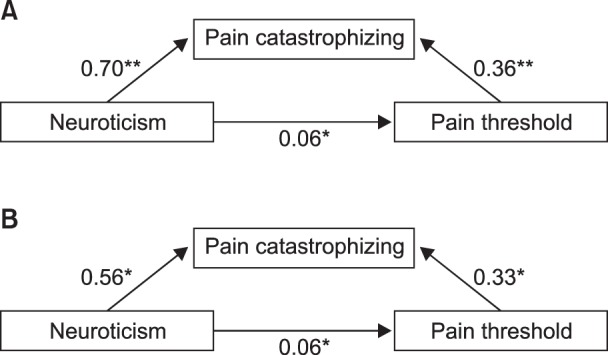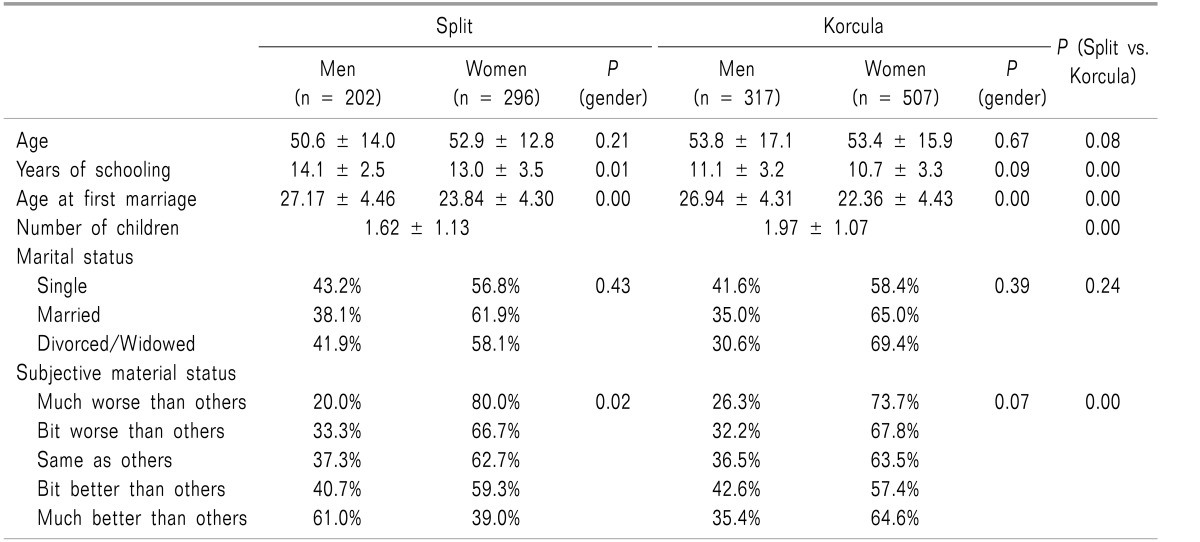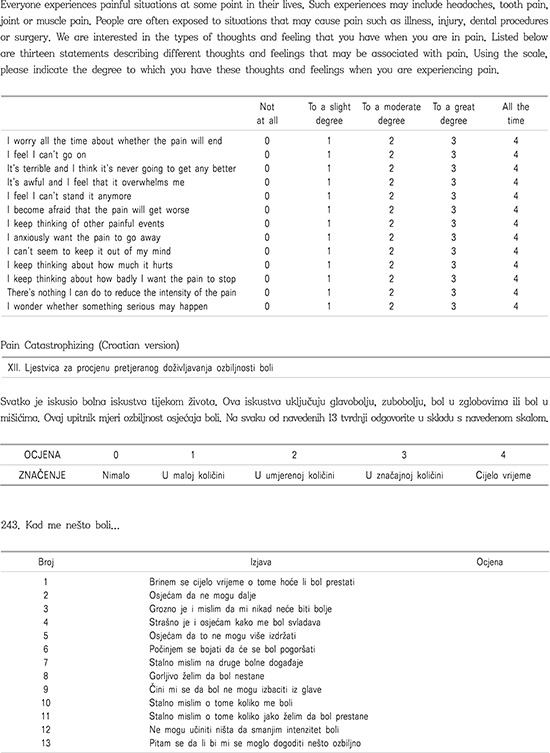1. Ebert MH, Kerns RD. Behavioral and psychopharmacologic pain management. Cambridge: Cambridge University Press;2010. p. 506.
2. al Absi M, Rokke PD. Can anxiety help us tolerate pain? Pain. 1991; 46:43–51. PMID:
1896207.

3. Garron DC, Leavitt F. Psychological and social correlates of the back pain classification scale. J Pers Assess. 1983; 47:60–65. PMID:
6220142.

4. Jones A, Spindler H, Jørgensen MM, Zachariae R. The effect of situation-evoked anxiety and gender on pain report using the cold pressor test. Scand J Psychol. 2002; 43:307–313. PMID:
12361099.

5. Tang J, Gibson SJ. A psychophysical evaluation of the relationship between trait anxiety, pain perception, and induced state anxiety. J Pain. 2005; 6:612–619. PMID:
16139780.

6. Gatchel RJ. Comorbidity of chronic pain and mental health disorders: the biopsychosocial perspective. Am Psychol. 2004; 59:795–805. PMID:
15554853.

7. Marbach JJ, Raphael KG. Phantom tooth pain: a new look at an old dilemma. Pain Med. 2000; 1:68–77. PMID:
15101965.

8. Wade JB, Dougherty LM, Hart RP, Rafii A, Price DD. A canonical correlation analysis of the influence of neuroticism and extraversion on chronic pain, suffering, and pain behavior. Pain. 1992; 51:67–73. PMID:
1454407.

9. Lahey BB. Public health significance of neuroticism. Am Psychol. 2009; 64:241–256. PMID:
19449983.

10. Smith TW, MacKenzie J. Personality and risk of physical illness. Annu Rev Clin Psychol. 2006; 2:435–467. PMID:
17716078.

11. Payne LA, Seidman LC, Lung KC, Zeltzer LK, Tsao JC. Relationship of neuroticism and laboratory pain in healthy children: does anxiety sensitivity play a role? Pain. 2013; 154:103–109. PMID:
23158759.

12. Malt EA, Olafsson S, Lund A, Ursin H. Factors explaining variance in perceived pain in women with fibromyalgia. BMC Musculoskelet Disord. 2002; 3:12. PMID:
12019032.

13. Affleck G, Tennen H, Urrows S, Higgins P. Neuroticism and the pain-mood relation in rheumatoid arthritis: insights from a prospective daily study. J Consult Clin Psychol. 1992; 60:119–126. PMID:
1556274.

14. Vassend O, Røysamb E, Nielsen CS. Five-factor personality traits and pain sensitivity: a twin study. Pain. 2013; 154:722–728. PMID:
23473786.

15. Goubert L, Crombez G, Van Damme S. The role of neuroticism, pain catastrophizing and pain-related fear in vigilance to pain: a structural equations approach. Pain. 2004; 107:234–241. PMID:
14736586.

16. Kadimpati S, Zale EL, Hooten MW, Ditre JW, Warner DO. Associations between neuroticism and depression in relation to catastrophizing and pain-related anxiety in chronic pain patients. PLoS One. 2015; 10:e0126351. PMID:
25902153.

17. Vervoort T, Goubert L, Eccleston C, Bijttebier P, Crombez G. Catastrophic thinking about pain is independently associated with pain severity, disability, and somatic complaints in school children and children with chronic pain. J Pediatr Psychol. 2006; 31:674–683. PMID:
16093515.

18. Swinkels-Meewisse IE, Roelofs J, Verbeek AL, Oostendorp RA, Vlaeyen JW. Fear-avoidance beliefs, disability, and participation in workers and non-workers with acute low back pain. Clin J Pain. 2006; 22:45–54. PMID:
16340593.

19. Sullivan MJ, Thorn B, Haythornthwaite JA, Keefe F, Martin M, Bradley LA, et al. Theoretical perspectives on the relation between catastrophizing and pain. Clin J Pain. 2001; 17:52–64. PMID:
11289089.

20. Vendrig AA, Hoofs MH, van Akkerveeken PF, Lamberts-Hopkes KJ. Multidisplinary approach to chronic back pain: postrehabilitation resumption of work the same 3–4 years later as after 6 months. Ned Tijdschr Geneeskd. 2000; 144:2207–2209. PMID:
11103259.
21. Lee JE, Watson D, Frey Law LA. Lower-order pain-related constructs are more predictive of cold pressor pain ratings than higher-order personality traits. J Pain. 2010; 11:681–691. PMID:
20356801.

22. Geisser ME, Haig AJ, Wallbom AS, Wiggert EA. Pain-related fear, lumbar flexion, and dynamic EMG among persons with chronic musculoskeletal low back pain. Clin J Pain. 2004; 20:61–69. PMID:
14770044.

23. Rollman GB. Measurement of experimental pain in chronic pain patients: methodological and individual factors. In : Melzack R, editor. Pain measurement and assessment. New York (NY): Raven Press;1983. p. 251–258.
24. Zisk RY, Grey M, MacLaren JE, Kain ZN. Exploring sociodemographic and personality characteristic predictors of parental pain perceptions. Anesth Analg. 2007; 104:790–798. PMID:
17377084.

25. Thorn BE, Ward LC, Sullivan MJ, Boothby JL. Communal coping model of catastrophizing: conceptual model building. Pain. 2003; 106:1–2. PMID:
14581103.

26. Miljković A, Pehlić M, Budimir D, Gunjača G, Mudnić I, Pavić A, et al. Can genetics aggravate the health of isolated and remote populations? The case of gout, hyperuricaemia and osteoarthritis in Dalmatia. Rural Remote Health. 2013; 13:2153. PMID:
23534916.
27. Vitart V, Biloglav Z, Hayward C, Janicijevic B, Smolej-Narancic N, Barac L, et al. 3000 years of solitude: extreme differentiation in the island isolates of Dalmatia, Croatia. Eur J Hum Genet. 2006; 14:478–487. PMID:
16493443.

28. Polasek O, Kolcić I, Smoljanović A, Stojanović D, Grgić M, Ebling B, et al. Demonstrating reduced environmental and genetic diversity in human isolates by analysis of blood lipid levels. Croat Med J. 2006; 47:649–655. PMID:
16909463.
29. Eysenck HJ, Eysenck SB. Manual of the Eysenck personality questionnaire: (EPQ-R Adult). San Diego (CA): Educational and Industrial Testing Service;1994.
30. Eysenck HJ, Eysenck SB. Priručnik za Eysenckov upitnik ličnosti EPQ (djeca i odrasli). Jastrebarsko: Naklada Slap;2003.
31. Sullivan MJ, Bishop SR, Pivik J. The pain catastrophizing scale: development and validation. Psychol Assess. 1995; 7:524–532.

32. Baron RM, Kenny DA. The moderator-mediator variable distinction in social psychological research: conceptual, strategic, and statistical considerations. J Pers Soc Psychol. 1986; 51:1173–1182. PMID:
3806354.

33. Hayes AF. Introduction to mediation, moderation, and conditional process analysis: a regression-based approach. New York (NY): Guilford Press;2013.
34. France CR, France JL, al'Absi M, Ring C, McIntyre D. Catastrophizing is related to pain ratings, but not nociceptive flexion reflex threshold. Pain. 2002; 99:459–463. PMID:
12406521.

35. Rhudy JL, Martin SL, Terry EL, France CR, Bartley EJ, DelVentura JL, et al. Pain catastrophizing is related to temporal summation of pain but not temporal summation of the nociceptive flexion reflex. Pain. 2011; 152:794–801. PMID:
21316150.

36. Wee LE, Sin D, Cher WQ, Li ZC, Tsang T, Shibli S, et al. “I'm healthy, I don't have pain”- health screening participation and its association with chronic pain in a low socioeconomic status Singaporean population. Korean J Pain. 2017; 30:34–43. PMID:
28119769.

37. Ghobadifar MA. An update on the management of diabetic neuropathic pain: a few comments. Korean J Pain. 2015; 28:158–159. PMID:
25852841.

38. Komasi S, Soroush A, Bahremand M, Saeidi M. Irrational beliefs predict pain/discomfort and emotional distress as a result of pain in patients with non-cardiac chest pain. Korean J Pain. 2016; 29:277–279. PMID:
27738509.

39. Thorn BE, Clements KL, Ward LC, Dixon KE, Kersh BC, Boothby JL, et al. Personality factors in the explanation of sex differences in pain catastrophizing and response to experimental pain. Clin J Pain. 2004; 20:275–282. PMID:
15322433.

40. Sullivan MJ, Martel MO, Tripp DA, Savard A, Crombez G. Catastrophic thinking and heightened perception of pain in others. Pain. 2006; 123:37–44. PMID:
16563630.

41. Osborn J, Derbyshire SW. Pain sensation evoked by observing injury in others. Pain. 2010; 148:268–274. PMID:
20005042.

42. Ferracuti S, De Carolis A. Relationships among Eysenck's extraversion, Rorschach's Erlebnistypus, and tolerance of experimental tonic pain (Cold Water Pressor Test). Percept Mot Skills. 2005; 100:237–248. PMID:
15773714.

43. Burns JW, Glenn B, Bruehl S, Harden RN, Lofland K. Cognitive factors influence outcome following multidisciplinary chronic pain treatment: a replication and extension of a cross-lagged panel analysis. Behav Res Ther. 2003; 41:1163–1182. PMID:
12971938.

44. Campbell CM, Kronfli T, Buenaver LF, Smith MT, Berna C, Haythornthwaite JA, et al. Situational versus dispositional measurement of catastrophizing: associations with pain responses in multiple samples. J Pain. 2010; 11:443–453.e2. PMID:
20439057.

45. Kunz M, Chatelle C, Lautenbacher S, Rainville P. The relation between catastrophizing and facial responsiveness to pain. Pain. 2008; 140:127–134. PMID:
18783885.

46. Lehmann R, Denissen JJ, Allemand M, Penke L. Age and gender differences in motivational manifestations of the Big Five from age 16 to 60. Dev Psychol. 2013; 49:365–383. PMID:
22545841.

47. Lynn J, Teno JM, Phillips RS, Wu AW, Desbiens N, Harrold J, et al. Perceptions by family members of the dying experience of older and seriously ill patients. Ann Intern Med. 1997; 126:97–106. PMID:
9005760.

48. Chapman BP, Duberstein PR, Sörensen S, Lyness JM. Gender differences in five factor model personality traits in an elderly cohort: extension of robust and surprising findings to an older generation. Pers Individ Dif. 2007; 43:1594–1603. PMID:
18836509.

49. Dixon KE, Thorn BE, Ward LC. An evaluation of sex differences in psychological and physiological responses to experimentally-induced pain: a path analytic description. Pain. 2004; 112:188–196. PMID:
15494200.

50. Mogil JS. Sex differences in pain and pain inhibition: multiple explanations of a controversial phenomenon. Nat Rev Neurosci. 2012; 13:859–866. PMID:
23165262.

51. Mogil JS, Bailey AL. Sex and gender differences in pain and analgesia. Prog Brain Res. 2010; 186:141–157. PMID:
21094890.

52. Mogil JS, Chesler EJ, Wilson SG, Juraska JM, Sternberg WF. Sex differences in thermal nociception and morphine antinociception in rodents depend on genotype. Neurosci Biobehav Rev. 2000; 24:375–389. PMID:
10781697.

53. Racine M, Tousignant-Laflamme Y, Kloda LA, Dion D, Dupuis G, Choinière M. A systematic literature review of 10 years of research on sex/gender and pain perception - part 2: do biopsychosocial factors alter pain sensitivity differently in women and men? Pain. 2012; 153:619–635. PMID:
22236999.






 PDF
PDF Citation
Citation Print
Print







 XML Download
XML Download